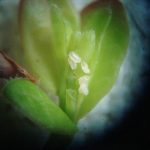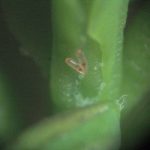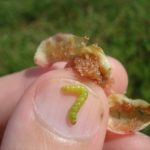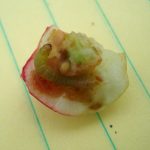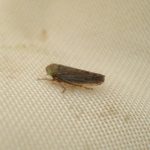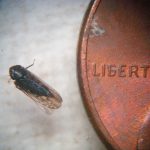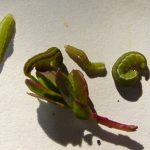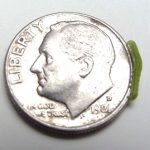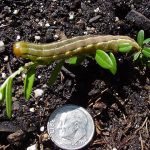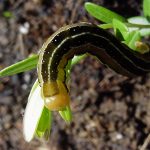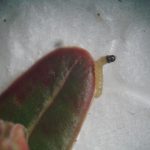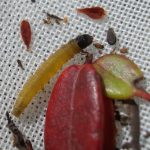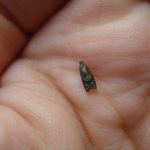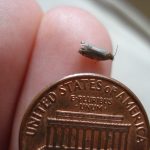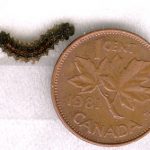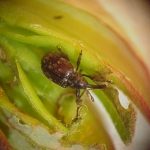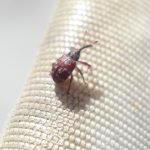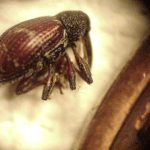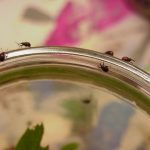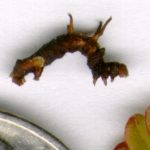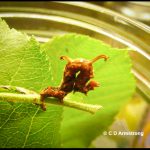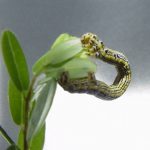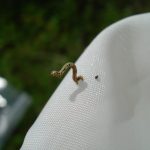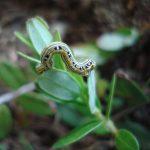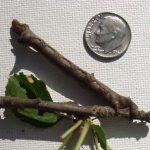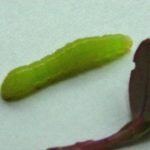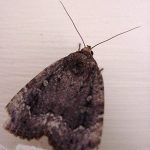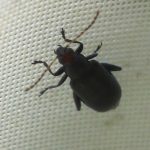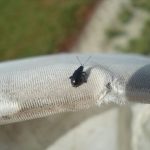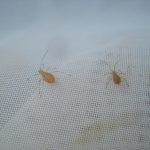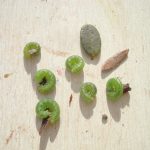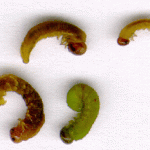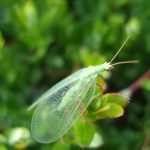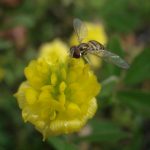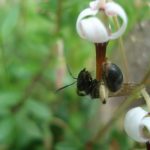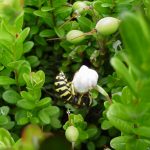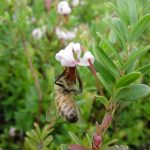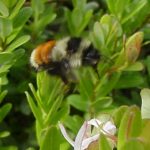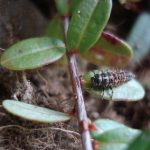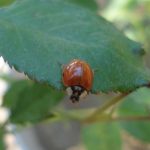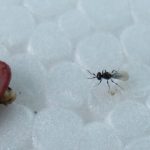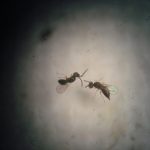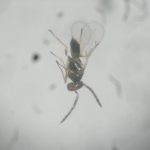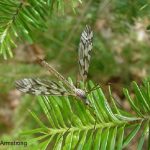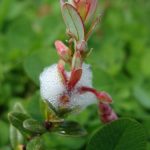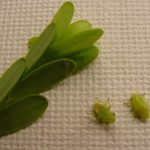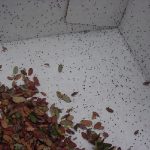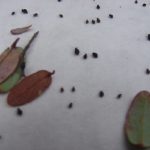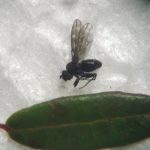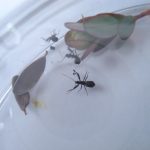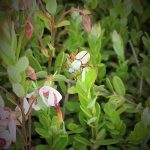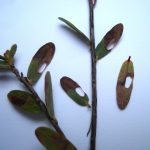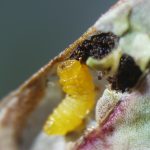Photo Collection
Photos of Insects found on Maine Cranberry Beds to Help with Identification
Color Photos (formatted for one standard piece of paper for easier printing and viewing, or when you’re without any mobile devices or can’t get online): Maine Cranberry Insect Photos (pdf) | Maine Cranberry Insect Photos (MS Word)
Maine Cranberry Insect Pests:
- Cranberry tipworm 2nd-instar larvae (white stage)
- Two Cranberry tipworm eggs
- Magnified view of a cranberry tipworm fly/midge – Dasineura oxycoccana (females are orange; males are black)
- Cranberry Fruitworm Larva
- Cranberry Fruitworm larva (they feed inside the berries and this berry has been broken apart to reveal the larva)
- An adult Blunt-nosed leafhopper resting on a cranberry insect sweep net (in Maine)
- Blunt-nosed leafhopper (on the rim of a 12″-diameter insect sweep net)
- Another magnified view of a Blunt-nosed Leafhopper Adult in Maine
- (Closer View) Blunt-nosed leafhopper adult in Maine (6/25/2015)
- False Armyworm Caterpillars (early instars)
- False Armyworm Caterpillar (early instar)
- False Armyworm Caterpillar (final instar)
- False Armyworm Caterpillar (final instar)
- Blackheaded fireworm larva
- Blackheaded fireworm larva (full-sized; final instar)
- Blackheaded Fireworm Larva (on a cranberry leaf)
- Blackheaded fireworm adult/moth (they are quite small)
- Blackheaded Fireworm Adult/Moth
- Blackheaded Fireworm Adult/Moth
- Spongy Moth (mid-sized larva)
- Cranberry weevil
- Cranberry weevil (on the rim of a 12″-diameter insect sweep net)
- Magnified view of a Cranberry weevil
- Magnified view of a Cranberry weevil next to a U.S. penny
- Cranberry weevil adults on the rim of an empty baby-food jar
- Cranberry blossomworm feeding on cranberry leaves in Maine
- Horned Spanworm (also called Filament Bearer), Nematocampa resistaria
- Horned Spanworm (Filament Bearer) (Washington County, Maine; 6/24/2004)
- Horned Spanworm Moth (Nematocampa resistaria) (shown with the empty pupa from which it emerged) (Washington County, Maine; 9/29/2008)
- A Green Spanworm
- Another example of a Chainspotted/Chain-dotted Geometer
- Chainspotted Geometer (spanworm)
- Chainspotted Geometer (feeding on a cranberry upright)
- A species of spanworm (possibly Big Cranberry Spanworm)
- Possibly a ‘Big Cranberry Spanworm’ or similar species (they are masters of camouflage; the portion angled up and closest to the dime is the spanworm) (Photographed 7/10/2003)
- Humped Green Fruitworm (mature larva)
- Humped Green Fruitworm (adult/moth stage)
- Red-headed flea beetle (magnified) (the head has a slightly reddish tint)
- Red-headed flea beetle on the rim of a 12″-diameter insect sweep net (Be looking for these guys late in the season, August and September)
- A pair of aphids (typical population levels of aphids are not a problem in cranberry)
- Cranberry Sawfly Larva
- Cranberry Sawfly Larvae. In the upper left corner of this picture, you can also see a minute wasp called a Sword-stabbing wasp, which parasitizes cranberry tipworm larvae.
- More sawfly larvae; they tend to curl into a C-shape when disturbed.
For more information and additional photos of most of the pests pictured above, visit the individual page for each pest that is of interest to you: Cranberry Tipworm || Cranberry Fruitworm || False Armyworm || Blackheaded Fireworm || Hill Fireworm || Humped Green Fruitworm || Spongy Moth || Cranberry Weevil || Cranberry Blossomworm || Red-headed Flea Beetle || Spanworms (green spanworm, horned spanworm, chainspotted geometer, etc.)
Beneficials (some representative examples):
- Green Lacewing (prey upon aphids, mites, thrips, small caterpillars, various arthropod eggs, etc.)
- A species of Syrphid fly (also called a Hover fly or Flower Fly) — Toxomerus marginatus (a natural enemy of cranberry tipworm larvae)
- Syrphid Fly (same species as adjacent photo)
- A species of solitary, ground-nesting bee
- A Yellowjacket (yellowjackets prey on caterpillars, grubs, etc.)
- European Honey Bee — Apis Mellifera (cranberries rely on insect pollination; the pollen is too heavy for the wind to carry it around very much)
- A Bumblebee — Bombus species (extremely effective cranberry pollinators which coevolved with cranberry)
- A Tiger Beetle (a specific type of ground beetle) (tiger beetles prey upon various other insects)
- A Ladybug Larva (they resemble miniature alligators and feast upon small, soft-bodied insects such as aphids, mites, and scales)
- An adult Ladybug (Just like their young, adults feed upon aphids, mites, scale insects, etc.)
- A parasitic wasp called a Sword-stabbing wasp which happens to aggressively parasitize cranberry tipworm larvae!
- Two Sword-stabbing parasitic wasps
- Closer view of a Sword-stabbing parasitic wasp
Curiosities (cause very little or no harm at all to cranberries, but are sometimes encountered on the beds):
- Crane Fly (adults do not feed, and the larvae feed primarily on decomposing organic matter)
- Mayfly adult (larvae are aquatic; the adults are short-lived)
- ‘Spit-like’ froth secreted by a Spittlebug larva (the larvae turn into froghoppers)
- Pair of Spittlebug nymphs removed from their protective, frothy ‘spit’ seen in the adjacent photo at left.
- Springtails (Collembola) (also called Snow Fleas but they area not fleas; they are very tiny, primitive hexapods that recently are no longer even considered to be insects) (each dark speck is a Springtail – view the next photo as well for a closer view of them)
- Springtails (Collembola) (closer view) (They are decomposers that are found virtually anywhere there is wet soil, and frequently anywhere where there is leaf litter or other decaying material)
- Type of Leaf beetle called a Calligrapha beetle (Family Chrysomelidae) (This one is likely Calligrapha multipunctata, which feeds on willow)
- Shore Fly (Ephydridae family) genus Scatella (pictured here 5/31/2007) (They live in wet areas, adults and larvae feed on algae, and they can occur in large numbers)
- A pair of assassin bug nymphs; probably Spinea complexa
- Assassin bug nymphs; probably Spinea complexa
- A Rose Chafer adult (probably just passing through); July 11th, 2019 (not a known cranberry pest)
- Cranberry leaves with distinctive holes caused by a leafminer insect which is shown in the adjacent photo at right – photographed 06/23/14
- A leafminer named Coptodisca negligens Braun which turns into a minute moth just 3.5 mm in length. Photo by B. Watt. (Only seen at one organic site in June of 2014 and not seen elsewhere to date)
- Cranberry leaves injured by a leafminer insect which is shown in the adjacent photo; the leaf tissue where the feeding occurred eventually breaks down leaving holes (as seen in the other photo) – photographed 06/23/14
Photos by Charles Armstrong

